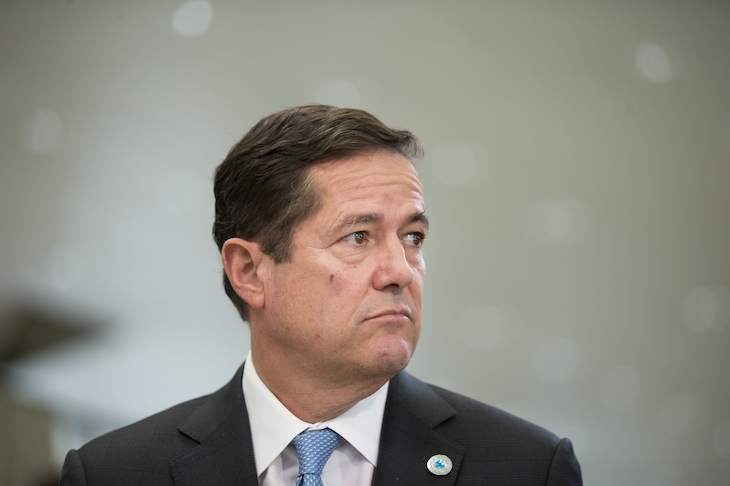What troubled places banks have become, I thought as I listened to two news stories, one concerning a formal reprimand for Barclays chief executive Jes Staley after he tried to uncover the identity of a ‘whistleblower’, the other trailing new revelations about the Libor scandal. But both, I’m afraid, were so badly explained that the majority of listeners must have been none the wiser.
The Staley episode is mysterious. Anonymous letters to Barclays directors made allegations about a recently recruited senior executive: Staley felt this was an ‘unfair personal attack’, believed ‘honestly but mistakenly’ that it was permissible for him to identify the author, and tried to do so with the help of a ‘US law enforcement agency’. This ‘error’ has cost him a big slice of bonus, though it won’t cost him his job.
Whistleblowers are entitled to anonymity under the Public Interest Disclosure Act 1998 as well as codes adopted by employers such as Barclays. Across the financial sector, the Speak Up campaign has positively encouraged them: HSBC chairman Douglas Flint spoke of ‘rewarding and celebrating’ those who share concerns about colleagues’ behaviour, ‘even if they are sometimes wrong’. One result was a cacophony of whistleblowers contacting the Financial Conduct Authority — up from 276 in 2009 to 1,376 in 2014 and 1,104 in 2015.
As with sex abuse allegations against public figures, a portion of these complaints are highly likely to be the inventions of poison pens. It’s impossible to judge the merits of the Staley case (regulators are still looking into it) from Barclays’ veiled public account. But what it clearly illustrates is the inner turmoil of a sector plagued by misbehaviour, mischief and malice.
The wrong Libor scandal
Then there’s the continuing fallout from the Libor scandal. The BBC made much this week of a recording, from 2008, of one Barclays manager instructing another to submit artificially low rates into the daily interbank Libor fixing because ‘we’ve had some very serious pressure from the UK government and the Bank of England about pushing our Libors lower’. How shocking is that?
Well, perhaps not as shocking as it looks — even if it appears to contradict select committee evidence given by the Bank’s former deputy governor, Sir Paul Tucker. The latter part of 2008 saw a liquidity panic in the City, in which the interbank lending market all but froze. Spikes in Libor would have given the impression — or confirmed the reality — that even the major banks involved in the daily fixing were finding other banks less willing to lend to them, amplifying the panic. So it’s not hard to imagine some officials believing that ‘pushing our Libors lower’ was a justifiable pragmatic response to an emergency in the banking system, even if it meant asking ‘rate submitters’ to lie.
And in terms of the degree of sin involved, that’s quite different from the other Libor scandal in which, over several years, traders in London, Tokyo and other centres habitually pressured rate submitters within their own and other firms, sometimes through brokers, to falsify Libor in order to favour their trading profits. That one really is a shocker. In effect, it was the corruption of an entire global market.
But attempts to bring justice to bear on it have been patchy: a long stretch for the UBS and Citigroup trader Tom Hayes, lesser sentences for four Barclays men, acquittals for everyone else collared by the SFO, including the six money-brokers who allegedly did Hayes’s bidding — and no taint on the careers of senior executives anywhere, even though the defence offered in every trial has been: ‘Our bosses knew exactly what we were doing, but turned a blind eye.’
The moral of these twin tales is that banking’s cataclysmic boom and bust left behind far too many allegations for them all to be dealt with in a wholly satisfactory way. Regulators and bank boards should focus on what (and who) was really bad, and encourage the media to explain it all better.
Fasten your seatbelts
Are you reading this in the departure lounge, en route to an Easter break? If like me you’ve chosen to fly with Ryanair, I suspect you will judge the experience by the ease of airport parking, the length of the security queue and whether they play that fanfare signalling ‘another on-time arrival’. Anything approaching decent cabin service will come as a bonus: you’ll hear things like ‘Gosh, these girls work hard considering they’re paid next to nothing’ or ‘Actually, this lasagne’s not bad for a fiver.’ Four years into a marketing programme called Always Getting Better, supposedly about being nicer to customers, the genius of the Ryanair model is that we still don’t expect pleasantness so long as we get cheapness and punctuality — and we laugh at the chutzpah of chief executive Michael O’Leary when we read headlines like ‘Ryanair threatens to double passenger fee for babies’.
Compare all this with British Airways, which long since ceased to be ‘the world’s favourite airline’, but resisted the no-frills revolution by continuing to present itself as a paragon of customer care, maintaining a slightly camp Home Counties tone to its cabin service that can feel 30 years out of date. Consumers’ criteria for judging BA are, I suggest, the opposite of those for Ryanair: never mind the delay, enjoy the in-flight entertainment and the elegant crockery. But now the national flag-carrier is reinventing itself as ‘British Bareways’ (says the Sun) by selling M&S sandwiches instead of offering free meals on short-haul flights, and threatening to do likewise on long-haul — while reducing leg-room and outdoing O’Leary for brutality by barring an elderly female passenger from using the toilet.
It’s a business-school case study in managing expectations. If your hallmark is comfort and courtesy, lower fares will never compensate customers for cuts and slip-ups. If your selling proposition is ruthless low-cost efficiency, play that on-time fanfare and you’ll be forgiven for everything else.







Comments